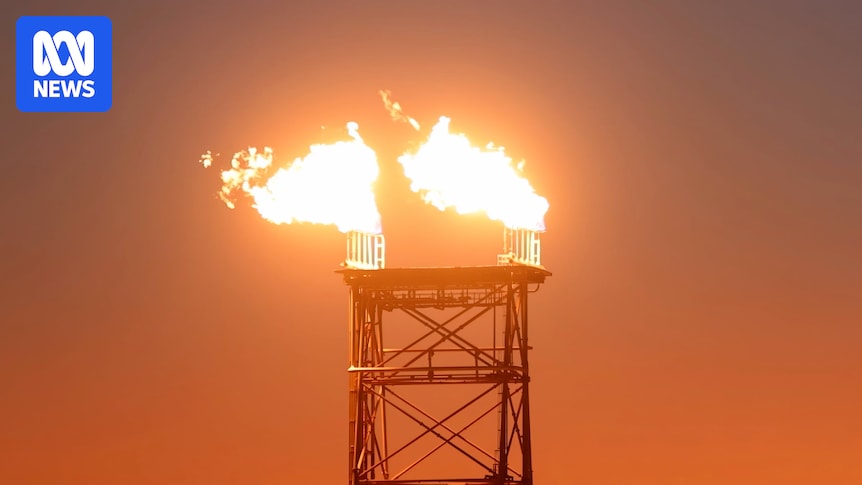Oil and gas giant Woodside’s fight to develop the huge Browse offshore gas fields has so far been fought on environmental lines.
Opponents say its proximity to the remote Scott Reef would cause irreparable damage to coral and marine life, and associated carbon emissions were too high in light of recent climate change impact reports.
Opponents of the project gathered in Broome on Friday, amid growing concerns about its impact on Scott Reef. (ABC News: Dunja Karagic)
But some analysts, such as head of energy research at MST Financial, Saul Kavonic, argue Woodside should be more worried about the project’s financial viability.
“The cost of the development itself … leave us with a questionable set of economics for the project,” he said.
Big up-front costs
The gas industry has had its eyes on Browse for decades, but past efforts have failed to clear the economic hurdle of drilling for gas in such a remote location.
Woodside needs to build a drilling platform, two floating production facilities and drill around 20 gas wells almost 300 kilometres off WA’s Kimberley coast.
To process the gas, it would need to be transported via a 900-kilometre pipeline to the North West Shelf facility in Karratha.
Mr Kavonic said the idea was considered and then abandoned 15 years ago.
“They [also] looked to do the James Price Point development [in the Kimberley], which turned out to be too costly,” he said.
“They looked to do floating LNG which turned out to be too risky.”
When Woodside abandoned plans to develop Browse as a floating LNG project in 2016, the WA premier at the time said the company was facing engineering costs above $50 billion.
Complicated joint venture
Another hurdle for the project is its complicated corporate structure.
While Woodside is the company the public associates with Browse, the project is a joint venture between several gas players who have agreed to share responsibility for its profits, losses and costs.
Mr Kavonic said any of the partners could effectively veto the project if they decided it was not in their interest.
Optimistic oil price
Mr Kavonic is not the project’s only sceptic.
A new report from climate research group Accela Research states many of the assumptions driving Browse’s profitability are “fragile”.
One of those is the long-term price of oil — the yardstick commonly used when the oil and gas industry plans for the future.
Developing Browse would mean drilling gas wells within 10 kilometres of the remote Scott Reef. (Supplied: Alex Westover)
Woodside is predicting the price of a barrel of oil will hover around $US78 over the next few decades.
But Accela Research financial analyst Axel Dalman said this put the company at odds with others in the industry, including BP, which he said forecast the price would be around $US50 in 2050.
“Whereas other companies think that, perhaps misguidedly, that oil demand will continue to be strong over the next few decades and that will keep prices high,” he said.
Mr Dalman said an imminent “glut” in global liquid natural gas (LNG) production, driven by Donald Trump’s ‘drill baby, drill’ agenda, was also likely to bring down prices.
The return of Donald Trump to the White House has sparked a spike in new LNG proposals. (ABC News)
“This new LNG coming out of the US will probably oversupply the market and drive down prices,” he said.
“That could be a problem for Browse because obviously the price of LNG is the biggest factor in how profitable the project is because it’s going to sell mostly LNG.”
But Mr Kavonic cautioned against reading too much into oil price predictions and short-term spikes in LNG supply.
“Browse will probably not be coming online until the early-to-mid-2030s,” Mr Kavonic said.
“So that’s well after the period of oversupply which some are forecasting between 2027 and 2030.”
A Woodside spokesperson said the company did not expect the current LNG supply wave to have a “sustained impact on pricing”.
“For example, the International Energy Agency’s concerns expressed in both 2009 and 2016 of a sustained LNG glut, with far-reaching impacts on gas prices, did not eventuate,” they said.
They said the company was committed to the current Browse to North West Shelf concept.
“[Woodside] remains focused on overcoming key challenges to the delivery of a globally competitive investment proposal.”
Browse to Darwin an option
Mr Kavonic said if the Browse to North West Shelf strategy does not work, eyes might turn towards the Ichthys LNG plant in Darwin.
The Inpex LNG plant in Darwin could be a more viable option to process the Browse basin gas than the North West Shelf in Karratha. (ABC News: Dane Hirst)
“The operator of that project has already built a very long pipeline out to the Browse basin to develop their Ichthys fields,” he said.
“That gas will start running out in about 10 years and then you could plug Browse into existing infrastructure rather than having to spend the money to build new floating infrastructure and new pipelines.”
A date for the final investment decision on the Browse to North West Shelf project has not been set, but is expected by the late 2020s.
